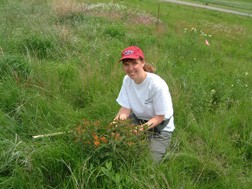The Climate Corner
- Share
- Tweet
- Pin
- Share
Monarchs are perhaps best known for their annual migration. In the summer, Door County monarchs that emerge as adults after mid-August join millions of other monarchs from southern Canada and the Upper Midwest and northeastern United States to fly to overwintering sites, oyamel fir forests in the mountains of central Mexico. While these monarchs look the same as their summer parents and grandparents, they are physiologically different.

Karen Oberhauser
Instead of mating and laying eggs soon after they emerge as adults, these monarchs are in an arrested development state called reproductive diapause. Most of them will not reproduce until the following spring. Another important difference is that these monarchs will live up to eight or nine months as adults, while the summer generations live about a month.
In Mexico, the monarchs are fairly sedentary, hanging in oyamel fir trees until mid-March, when they migrate northward, laying eggs in northern Mexico and the southern United States. Their offspring continue the northward migration, escaping hot temperatures in the south and tracking the appearance of their milkweed host plants. There are two to three more generations before the southward migration begins in late August.
Because monarchs are cold-blooded, their development rates depend strongly on temperature. Extreme temperatures can directly affect monarchs of all life stages (eggs, caterpillars/larvae, chrysalids/pupae, and adults). While egg production and growth rates usually increase with increasing temperatures, very hot temperatures reduce the number of eggs females lay and can result in slower development rates and mortality in larvae and pupae. No monarch life stage can withstand either short periods of extreme cold or prolonged periods of several degrees below freezing. The climate in the Mexican wintering sites is perfect for monarchs; the dense oyamel fir stands mediate temperature extremes, cooling the forest during the heat of the day, and warming it at night.
Severe weather events, which are predicted to increase in frequency, can also have direct negative impacts on monarchs. An early 2002 snowstorm in the Mexican overwintering colonies killed up to 80 percent of all of the monarchs that were there.
In addition to direct effects on the monarchs themselves, climate change could alter the habitats on which monarchs depend. Recent research suggests that the suitable area for oyamel firs in Mexico will decrease by almost 70 percent by 2030 and almost completely by 2090 as a result of changing temperature and precipitation regimes. Thus, even if monarchs could survive in the changed climate, they’d be wintering in a changed plant community, and it’s not clear that this community could support them. Furthermore, severe drought in the southern U.S. means that the monarchs moving into Texas in the spring may not find their milkweed host plants in good condition, and those migrating south through Texas in the fall may not find adequate nectar supplies.
Climate changes could also affect monarch interactions with their natural enemies. Changing temperature or precipitation could affect parasite and predator abundance. It’s even possible that changing milkweed quality could affect the attractiveness of monarchs to their natural enemies by altering their nutritional quality as prey.
Finally, temperature can trigger changes in monarch physiology and behavior. For example, scientists have found that temperature provides an important cue for adult monarchs. Prolonged exposure to cold temperatures, similar to those in the Mexican overwintering sites during the winter, triggers the northward flight of migratory monarchs in the spring. Higher temperatures may affect the timing of diapause or even the monarch migration itself.
Ultimately, monarchs’ ability to respond to climate change will depend on the availability of their food sources: milkweed for the caterpillars and nectar for the adults. Since climate change is expected to result in more variable conditions, our conservation efforts should ensure that milkweed and nectar are available throughout the monarchs’ range – when conditions are bad in one location, monarchs may be able to find better conditions elsewhere. Additionally, since monarch ranges might shift northward, it is important to emphasize conservation efforts in the northern part of their range, including Door County.

Karen Oberhauser is a professor in the Dept. of Fisheries, Wildlife and Conservation Biology at the University of Minnesota, where she and her students conduct research on several aspects of monarch butterfly ecology. She is chair of the Monarch Joint Venture, and a founding officer of the Monarch Butterfly Fund. In 2013, Karen received a White House Champion of Change award for her work with Citizen Science. She looks forward to spending more time in Door County.
The Climate Corner is a monthly column featuring a variety of writers from around the state and Door County addressing various aspects of the challenges and opportunities climate change presents. The Corner is sponsored by the Climate Change Coalition of Door County, which is dedicated to “helping to keep our planet a cool place to live.” The Coalition is always open to new members and ideas. Contact the Coalition at: [email protected].

